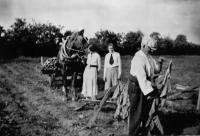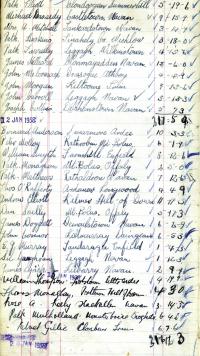Death and taxes: tobacco-growing in Ireland
Published in 18th–19th - Century History, 20th-century / Contemporary History, Early Modern History (1500–1700), Features, General, Issue 2 (March/April 2013), Volume 21
Tobacco-harvesting in Stackallen, Co. Meath, in the 1930s. (Meath County Library)
If Benjamin Franklin’s axiom assures us of the certainty of two things only—death and taxes—the Irish can add further to that list, and indeed link the two. For what was an Irish death without an Irish wake, and what was an Irish wake without an abundance of tobacco? And what were such proportions of consumption without accepted and expected exorbitant proportions of tax on this luxury product? As late as the 1950s, the accepted formula for the Irish wake involved the laying on of generous amounts of whiskey and clay tobacco pipes for the consumption of mourners—each use of the pipes being accompanied by the mantra Seacht lán reilic Padh-ruig agus tomba Ghriosd go bheannachtaibh le h-anam na marbh (‘Seven days in the grave, ’till you rise to the blessed souls of the dead’) as a prayer for the dead. Although the 2002 smoking ban has led to a clearance of the fug of illogic and the extension of that prohibition to homes, the Irish love affair with tobacco continues—it is estimated that 29% of the population are habitual smokers.
With the experience of a fourth dreary and sodden summer in a row, some readers might be surprised to learn that tobacco was once quite a popular crop in the more eastern counties of the island. Although Walter Raleigh is generally credited with the introduction of the potato and tobacco to the ‘Old World’, the notion of widespread tobacco cultivation in Ireland was first proposed in The improvement of Ireland (c. 1698) by the Jacobite Thomas Carte:
‘. . . a valuation should be given to the King: and so prohibit all forraign Tobacco: and in Lieu thereof sett up a Plantation here? The land is indifferently good for the same: the clymat warm enough: experience hath prov’d it: and further skill would make the tobacco sufficiently palatable.’
Alas, this advice seems not to have been taken up by the relevant authorities—perhaps owing to the author’s political allegiances! Further, Carte’s suggestion was being made in the face of an existing ban on tobacco cultivation, initiated by James I in England and extended to Ireland by Charles II some decades later.
The removal of this prohibition in the latter part of the eighteenth century led to an upsurge in tenant farmers cultivating the crop, and we know that by 1831 the tobacco plant was being extensively grown in County Wexford in particular. This was most likely due to the favourable conditions that prevailed there climatically and agriculturally. Knowledge of such conditions comes to us from An essay on the climate of Ireland (1831), which, interestingly, also notes that:
‘About 1632, artichokes, colly flowers, pompions and hops seem to have been first introduced and grow very well […] if they had been introduced at an earlier period, there is little doubt but that they would have succeeded as well. The same reasoning holds good for the tobacco, cultivated at present to such an extent in the county of Wexford.’
One estimate has it that a fifth of all tobacco consumed in the United Kingdom during this period originated in Ireland, and the success in growing tobacco on reclaimed bogland was almost certainly a factor in the commercial spread of the crop. There is no conclusive explanation for the appearance of tobacco-growing in the country at this time, though one theory has it that the long-term impact of the revolution in America—itself a prime producer of tobacco during this period—was a contributory factor, as the constitutional fallout from that conflict was not satisfactorily resolved until the treaty of 1818, signed by Britain and the United States.
A twentieth-century pioneer of tobacco cultivation in Ireland often claimed that the greatest obstacle to the growth of the crop in Ireland was never climatic but rather political, and in 1832 a prohibition act specific to Ireland was passed in Westminster, with Messrs O’Connell and Spring Rice speaking out against it. Later that century, in an essay on Ireland’s financial position within the Union, C.F. Bastable candidly stated that
‘. . . the prohibition of its [tobacco] cultivation in 1832 seemed an interference with industry . . . Tea, tobacco and spirits, all objects of comparatively large consumption in Ireland, are specially selected for taxation and therefore afford a considerable yield.’

Tobacco-grower’s ledger, January 1938, County Meath. (Meath County Library)
Dev’s protectionism
The spirit of self-sufficient protectionism that pervaded Ireland under de Valera in the 1930s led to the last significant flowering of tobacco cultivation in the country. The government of the time—and agriculture minister Séamus Ó Riain in particular—decreed that, henceforth, cigarettes were to contain a percentage of native tobacco. Ó Riain, interestingly, was a TD for the Wexford constituency, so perhaps politics was a spur as well as an obstacle to the crop in Ireland. Tobacco experts such as Kentuckian G.N. Keller, who had come to Ireland in an official capacity almost 30 years before, were on hand to facilitate this new project, and by 1934 some 750 acres of land were under tobacco cultivation in counties Wexford, Carlow, Laois, Kildare, Kilkenny, Meath, Wicklow and Offaly. It was a popular crop, according to Meath county councillor J.P. Kelly, who stated in 1934 that ‘people who grow tobacco had made money beyond their dreams’. The knock-on effect of this industry could be seen in Belfast, where tobacco-processing was one of the only industries that actually expanded during this period; the number of people employed in this industry increased by up to 30%.
Unfortunately for the government, the truism of protectionist home industry inevitably leading to heavy subsidisation took effect. Encouraged by the money to be made, increasing numbers of farmers now sought to introduce tobacco onto their land. Alarmed, the government responded by introducing strict new legislation concerning the price paid for tobacco and restricting growing permits only to those who had taken part in the 1933 growing season. The experiment in significant tobacco self-sufficiency was at an end. A measure of this failure can perhaps be gauged from an article in Béaloideas in 1958 concerning County Wexford, hitherto the county most involved in tobacco cultivation: ‘In 1954, it was recorded that in the Clonroche district of County Wexford people smoked the dry withered bark near the stump of a furze bush as a substitute for tobacco’. HI
Gearóid Ó Faoleán is a Ph.D student at the University of Limerick.
Further reading
J. Feehan, Farming in Ireland: history, heritage and environment (Dublin, 2003).
D. Hoctor, The Department’s story: a history of the Department of Agriculture (Dublin, 1971).
















